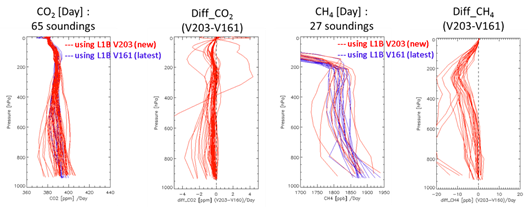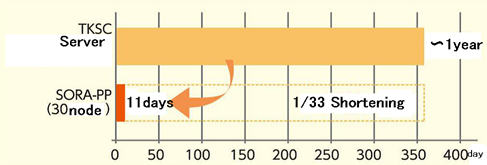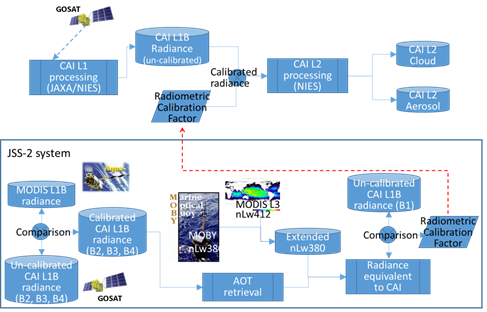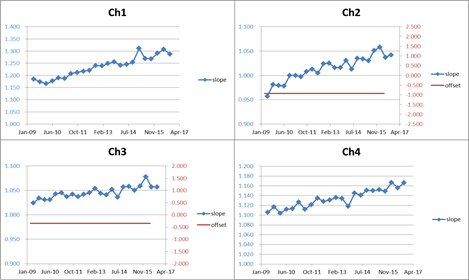Greenhouse gases Observing SATellite (GOSAT) mission
JAXA Supercomputer System Annual Report April 2016-March 2017
Report Number: R16E0096
- Responsible Representative: Masakatsu Nakajima(Space Technology Directorate I, GOSAT-2 Project Team)
- Contact Information: Yoko Ueda(ueda.yoko@jaxa.jp)
- Members: Makiko Hashimoto, Jun Yoshida, Kenji Kowata, Hideki Suetake, Hisanori Tanaka, Yuuji Shinitsuka, Makoto Imanaka, Yoshifumi Yamamoto, Koji Sakurai, Akiko Otomo, Masahiko Kato, Yoko Ueda, Tomoo Yamasaki, Shigeru Iguchi, Masakatsu Miyahara, Takashi Goto, Hidetoshi Hayasaka, Asahi Konno, Takahito Tamagawa, Atsushi Shimizu, Ryoutaro Saka, Mamoru Sugawara, Kyoko Tokunaga
- Subject Category: Space(Satellite operation)
Abstract
GOSAT continues its observations beyond its 5-year mission, providing well-calibrated high spectral resolution data. The overall functions and performances are successful and no significant degradation of SNR and spectral resolution has been observed. Several anomalies were found onboard, but they have stabilized since. The Level 1 algorithms have been updated since launch in order to correct these anomalies.
Goal
GOSAT observe carbon dioxide and methane – two major green-house effect gasses – from space, then we obtain better understanding in the science of behavior of these gasses. The knowledge serves as a basis for devising global warming countermeasure means.
Objective
(I) To contribute to environmental administration by monitoring the global distribution of greenhouse gases(GHGs),
(II) Estimating the CO2 sources and sinks on asub-continental scale and verifying the reduction of GHGs emissions
(III) To advance earth observation technologies for future missions
References and Links
Please refer ‘HOME – GOSAT – JAXA‘.
Use of the Supercomputer
GOSAT mission utilizes JSS2 as one of the GOSAT Mission Operation System which processes the observation data of GOSAT. When processing algorithm is updated, JSS2 reprocesses all data observed in the past. When we calibrate products, JSS2 processes all data in the past. Also, JSS2 is used as a remote storage of all data required for its reprocessing.
Necessity of the Supercomputer
As the reprocessing targets of GOSAT products extends to all data observed in the past, more computer resources (core, memory, storage, etc.) are required than in the real-time processing.
It is necessary to use JSS2 to shorten the reprocessing time and to provide the reprocessing products to GOSAT users more quickly.
Achievements of the Year
1.GOSAT TANSO-FTS Level-1 Reprocessing
We reprocessed 7 year TANSO-FTS data by utilizing JSS2 (30nodes) to correspond with version-up of L1 algorithm, and with next version-up evaluation sample. It took only 11 days, and we could verify speed-up more than 30 times comparing to one year by using the conventional GOSAT L1 processing computers.
2.Calibration and validation, and research processing
(1) Calibration and validation of GOSAT TANSO-CAI data
On-orbit sensor sensitivity change is evaluated from TANSO-CAI observation data. We expect to determine the CAI Band 1 radiometric calibration factor (or formula) by calculation of radiative transfer model using in-situ and other satellite data. The CAI Band 1 has an important information of aerosol size distribution. Hence, Band 1 radiance is optimized to agree with calibrated radiances of Band 2 and Band 3. Calibration formula of Band 2 and Band 3 are obtained as three candidates. Thus, Band 1 calibration factor is determined by calculations in these three cases.
Data period: June 2009 – February 2017 (every 4 months, 23 months in total)
(2) Research processing of GOSAT TANSO-FTS thermal infra-red data
Level 2 algorithm is improved for utilization of TANSO-FTS thermal infra-red (TIR) data. After implementation of TIR Level 2 programs to JSS-2 system and re-processing of TIR Level 2 product, we know the processing performance of JSS-2.
① Implementation of TIR Level 2 programs
(a) Vertical profiles of Carbon dioxide (CO2) and Methane (CH4)
(b) Cloud detection, Surface temperature and emissivity
② Re-processing of TIR Level 2 product
TANSO-FTS TIR Level 2 product is re-processed by using new version of the Level 1B product (V203.203) for one year data of 2010. The developing new Level 2 product is evaluated in comparison with the latest version of TIR Level 2 product.
③ Performance of TIR Level 2 processing in JSS-2
TIR Level 2 processing of one year data shows the JSS-2 system performance (180 nodes) is about (a) 6 times and (b) 10 times higher than the EORC GOSAT research system (40 nodes).

Fig. 4:GOSAT FTS TIR retrieved CO2 and CH4 profiles by using two L1B versions (V161 and V203) with their differences. Analyzed data are around Los Angels in 2010.
Publications
N/A
Computational Information
- Parallelization Methods: Serial
- Process Parallelization Methods: n/a
- Thread Parallelization Methods: n/a
- Number of Processes: 180
- Number of Threads per Process: 1
- Number of Nodes Used: 15, 30
- Elapsed Time per Case (Hours): 0.0167, 0.1333
- Number of Cases: 9
Resources Used
Total Amount of Virtual Cost(Yen): 10,337,372
Breakdown List by Resources
| System Name | Amount of Core Time(core x hours) | Virtual Cost(Yen) |
|---|---|---|
| SORA-MA | 0.34 | 0 |
| SORA-PP | 638,408.18 | 5,450,729 |
| SORA-LM | 0.00 | 0 |
| SORA-TPP | 291,752.75 | 4,301,894 |
| File System Name | Storage assigned(GiB) | Virtual Cost(Yen) |
|---|---|---|
| /home | 1,213.62 | 11,448 |
| /data | 2,733.87 | 25,788 |
| /ltmp | 55,989.61 | 528,151 |
| Archiving System Name | Storage used(TiB) | Virtual Cost(Yen) |
|---|---|---|
| J-SPACE | 6.27 | 19,360 |
Note: Virtual Cost=amount of cost, using the unit price list of JAXA Facility Utilization program(2016)
JAXA Supercomputer System Annual Report April 2016-March 2017






